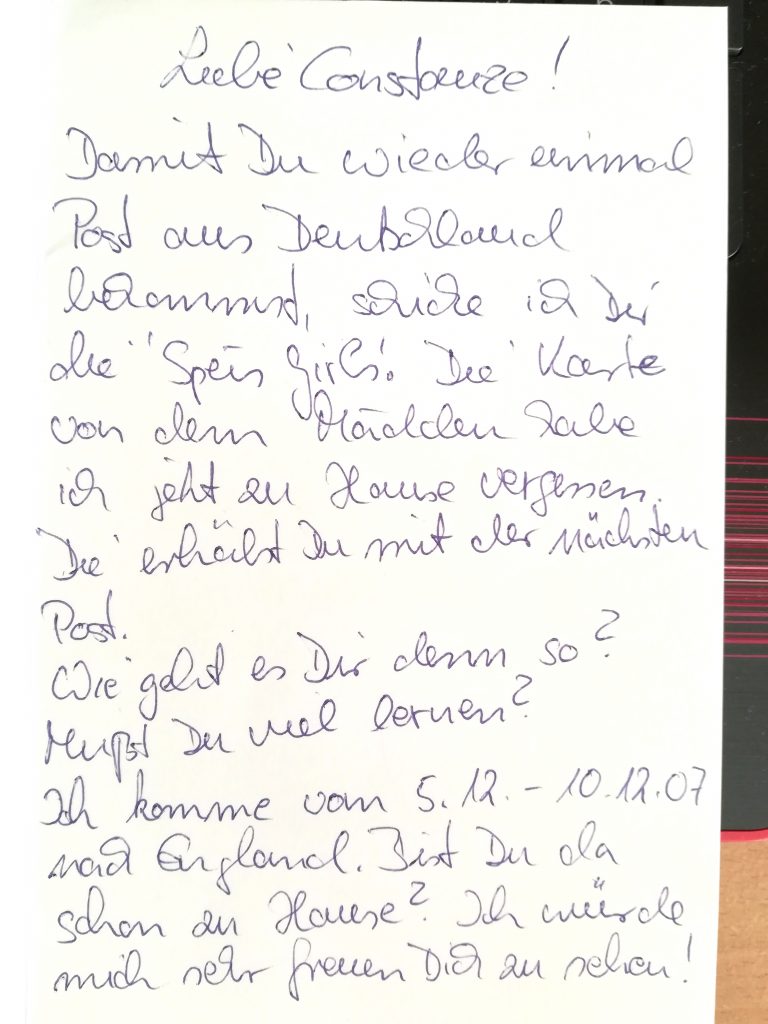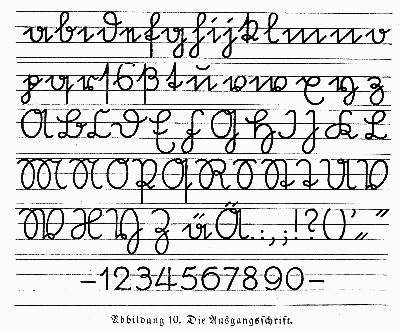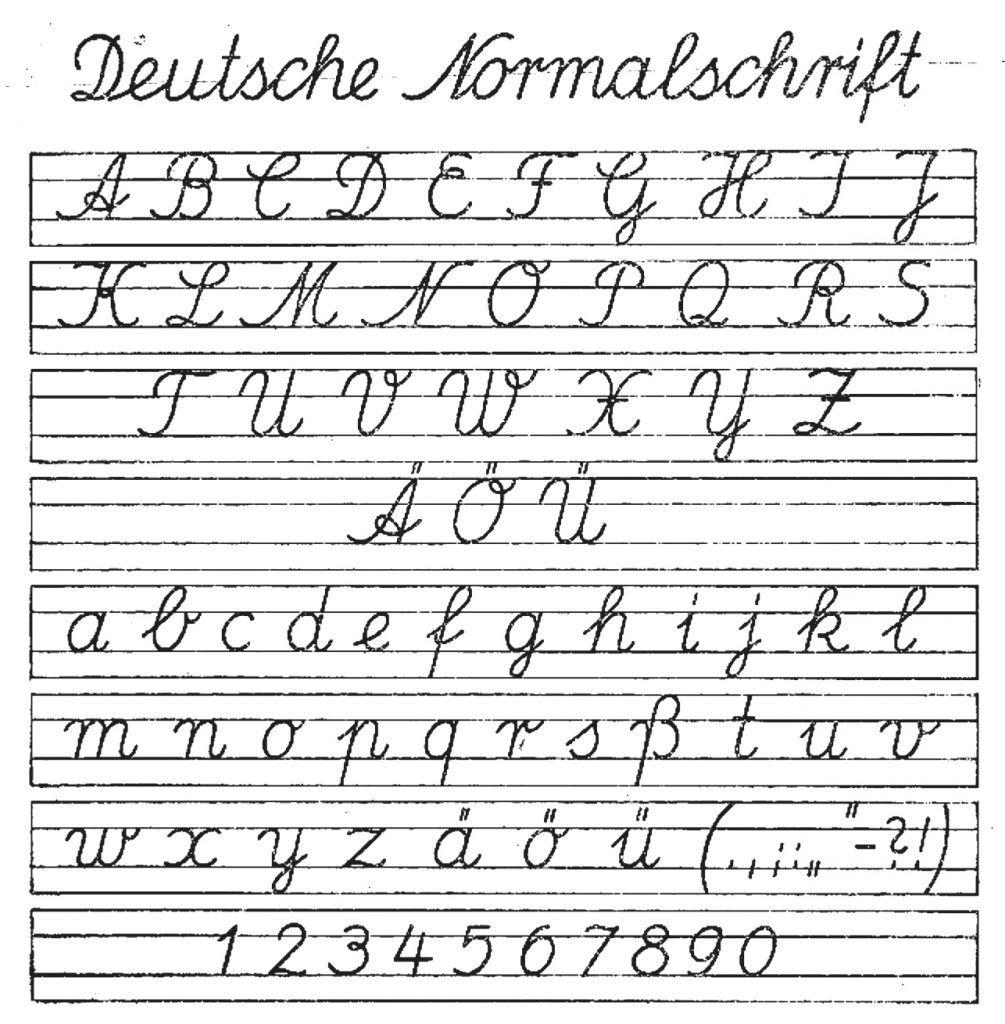Old German Handwriting Posted by Constanze on Oct 10, 2018 in Language
When I was young there was an old German poster in my family kitchen that used to drive me insane, because although I knew it was in German, I couldn’t read what was written on it. It looked to me like another language! “It’s because that is old German handwriting”, my mum told me. “Some of the letters look very different.” Today I’d like to show you what old German handwriting looks like, should you ever be faced with the same, confusing situation!
A little history first!
Old German Handschrift (handwriting), known as die Kurrentschrift or Kurrent for short in German, but also known simply as die alte deutsche Schrift (‘Old German script’), was closely modelled on the handwriting used in das Mittelalter (medieval times).
An updated version of Kurrent called Sütterlin was developed in the early 20th Century, and was used and taught in German schools until the government changed it to deutsche Normalschrift (‘normal German script’). This updated handwriting resembled das lateinisches Alphabet (Latin alphabet) more closely, and is the German handwriting that is still used and taught today.
Significant differences between old and new German handwriting
A point of confusion with old German handwriting is that some of its letters don’t look like their modern counterparts. The characters for c, e, n, m, and u, for example, all look very similar, while the h looks more like an f. If you are interested in learning what the old letters look like, study this photo of Kurrentschrift to familiarise yourself with them:
Kurrentschrift:
Sütterlin (the updated version of Kurrent, used in early 20th Century):
Deutsche Normalschrift:
Unlike old German, modern German handwriting is fairly easy to read and follow. Be sure to look out for the number 1, which can resemble a 7 at times. This is especially important when it comes to addressing letters and giving card details, for example!Here is a card sent to me by my German aunt, so you can see what modern German handwriting looks like ‘in action’!


Build vocabulary, practice pronunciation, and more with Transparent Language Online. Available anytime, anywhere, on any device.







Comments:
John E Loth:
Very interesting. I am looking now for computer program to “translate” Fraktur into Roman Script. I can read Fraktur but I have some literary works which I would prefer to read in modern script. Hope you can provide a suggestion. Thanks for your post. BTY, I am fairly fluent in speaking and very fluent in reading German. Less good when it comes to writing but you are very fluent in both languages. Look forward to hearing back from you.
regards
John Loth
Constanze:
@John E Loth Hi John, there is a list of websites on here that might be of use to you! https://www.familytreemagazine.com/premium/7-websites-for-deciphering-old-german-script/
Tom Dawkes:
The older styles of German handwriting share many characteristics of the early English Secretary hand, and of course the long ‘s’ was current in English handwriting and printing until the early 19th century. You can download a Sütterlin font at http://www.suetterlinschrift.de/Englisch/Sutterlin.htm, and there are numerous tips and examples of how to approach this style.
Karen:
Hallo Constanze,
Danke for posting this interesting subject on the old Deutsch handwriting. Wouldn’t it be nice if it was still being used today?
Cheers!
Cecilia:
Hallo Constanze! Das mit der Handschrift ist mega interessant, ich habe noch Probleme um sie zu lesen…
LG
Joseph T Madawela:
this is very interesting thank you!
Allan Mahnke:
I have seen letters from my grandparents’ families, written roughly 1890-1900, that are a curious blend of the older style and modern. They use forms from all three styles (sometimes 2 or 3 shapes for the same letter) in the same piece of correspondence. By roughly 1920, it seemed the earliest letter shapes had disappeared, at least within our family.
By the way, I recognize your chart from my own childhood. I saw it in a book and on someone’s wall. I learned the shapes, but never really became a fluent reader.
Sybille Schellack:
Thank you so much! I have been researching my roots through Ancestry and many of the documents are in that old handwriting. I really had a hard time with that. My mother used to tell me about the old handwriting (alphabet), but I didn’t know how to search for it. Vielen Dank!
Fred:
Hallo Constanze,
einen Superblog betreibst Du hier. Vielen Dank dafür.
Für Deine Leser (und auch deine deutsche Tante?) schicke ich Dir einen schönen Link: http://www.spiegel.de/kultur/zwiebelfisch/zwiebelfisch-abc-haeltst-haelst-a-314548.html. 🙂
Liebe Grüße
Fred
Alcazar:
Nice blog as always 🙂
Not to brag, but me can read and write Sütterlin, because me learnt it during my first profession 🙂
Its easier to read old writings then to understand it, because language changes over time as you know.
Thanks.